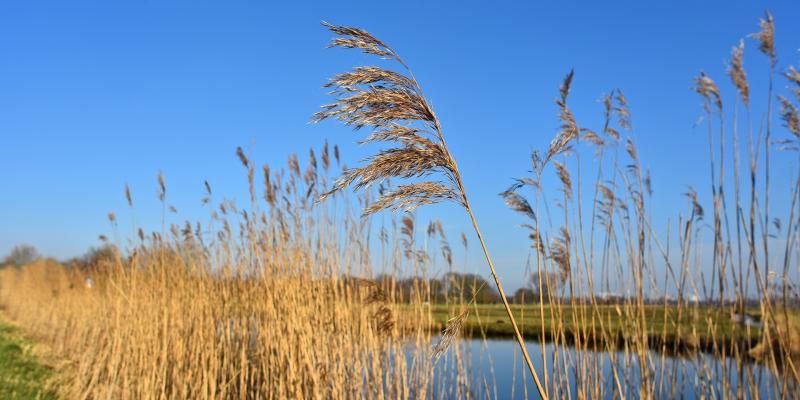How to Get Rid of Phragmites
 Last updated: 07/20/21
Last updated: 07/20/21
Estimated read time: 5 minutes
You may not have heard of phragmites before, but you’ve definitely seen them around. Also known as the common reed, this invasive species of grass is tearing across Maryland and the mid-Atlantic coast and is outcompeting beneficial native varieties—luckily, there’s plenty that can be done!
What are Phragmites?
Phragmites (frag-mite-eez) is a non-native marsh grass. Preferring wet areas and often growing near water, invasive phragmites grow in dense patches with stalks often reaching upwards of 13 feet tall!
While they produce seeds, phragmites most often spread through subterranean rhizomes, making effective eradication difficult. Of all of the invasive marsh grasses, phragmites are among the toughest and most persistent in all of the Chesapeake region.
What Problems do Phragmites Cause?
Out of control phragmites can cause a host of problems for an affected area, including:
- Fires: Each winter, phragmites’ above-ground growth dies back, leaving behind dense patches of dry, highly flammable material. Naturally, this is an ideal fire starter and can cause serious wildfires without proper monitoring.
- Biodiversity: With their fast, dense growth, phragmites quickly outcompete native plant life, creating large areas of a biological monoculture. This has a predictably negative effect on local biodiversity and can cause large areas of beneficial native plants to die.
- Economic activity: Particularly on the Chesapeake Bay, dense patches of phragmites can choke out recreational water areas such as marinas and fishing spots. For a region that depends heavily on water-based commerce and tourism, anything that can disrupt local waterways must be taken seriously.
How to Control Invasive Phragmites
While phragmites can be tough to get rid of, they aren’t indestructible. The best way to control invasive phragmites is by treating the plants with specific herbicides approved for aquatic use. This approach treats both the plant growth itself and allows native species to repopulate the newly cleared land.
At Blades of Green, we’re the only company that treats phragmites in our area, and we have more than 30 years of experience! It requires special permits and the treatment window is very small so experienced, professional phragmites control is always the way to go.
How do Phragmites impact the Environment?
In small amounts, phragmites can be beneficial as wildlife habitat—but the much more common dense growths provide no tangible benefit to native species, often impeding the local ecosystem. Ways they impact the environment include:
- A thick layer of wrack can form when the plant’s lower leaves die off, preventing native plants from germinating.
- Its stalks can clog waterways, which can hinder fish travel.
- They can also affect the nesting habit of saltmarsh sparrows, a bird species that is threatened to be extinct by 2050.
Are Phragmites Native to Maryland and Northern Virginia?
When attempting to control phragmites, it’s important to remember that both the native and invasive varieties are found in Maryland and Northern Virginia.
- Invasive phragmites are usually dull tan in color while the far more rare native species display a slightly red or purple hue.
- Additionally, invasive phragmites’ stems spread horizontally while the native ones tend to grow more vertically and their leaves hug the stem tightly.
How did Phragmites Get into the Chesapeake Bay?
Tracing the history of the invasive phragmites can be difficult. Still, historians and botanists agree that they arrived on our shores in ship ballast material sometime in the late 1700s or early 1800s. They likely originally arrived in the region with European colonists, but some varieties may also have come from Central or South America via trade. However they got here, though, it didn’t take long for them to find a home on the Chesapeake Bay.
What eats Phragmites?
As a non-native species, phragmites don’t have many native predators, though a few native waterfowl and Canadian geese are known to consume their seeds. Interestingly, one of the most effective animals in the fight against invasive phragmites is the humble goat! With their rugged teeth, voracious appetites, and ability to digest even the toughest plant matter, goats are an ideal candidate when it comes to clearing dense patches of phragmites. While controlled goat grazing doesn’t eliminate phragmites, it does allow native plants to move into newly cleared patches and reclaim the land.
How Long Does it Take for Phragmites to Grow?
One of the phragmites’ most significant advantages over both native and other invasive species is how fast it grows, with vertical growth measuring as much as 15 inches a year. Even worse are its runners, often referred to as stolons—these can grow 4 inches a day, aiding the plant in its rapid spreading. It’s little wonder then that phragmites pose such a serious threat to our local wetlands.
How Deep are Phragmite Roots?
Another potent weapon in phragmites’ arsenal is their root systems. They grow in dense, difficult-to-remove clusters that can often reach depths of over 6.5 feet. Similar to dandelions or Queen Anne’s lace, removing the above-ground growth won’t kill, as the plant will just come right back.
Can you Cut Down Phragmites?
Cutting down phragmites is only effective after the application of spray treatments. Due to their deep roots and ability to regrow quickly, simply cutting down the stalks is not a viable control method. Once the proper amount of time has passed after herbicidal treatment though, usually, 3-4 weeks, proper cutting that leaves only a 6-inch stump behind can make a difference and curb their spread.
When is the Best Time to Treat Phragmites?
As we said before, the window to treat phragmites is a narrow one indeed. The only time that treatments have been shown to work is in late July through October depending on weather, however, a permit is required which needs to be obtained in advance. Additionally, treatment must be repeated every year if it is to work over a long period of time.
Have a Question About Lawn Care? Ask the Experts!
Having a lawn care problem that you can’t seem to solve? Send your question to our expert technicians and get the answers you need to get a healthy, beautiful lawn.
Ask a Lawn Care QuestionConsider Professional Lawn Care
End the guesswork and stress of lawn maintenance. Let our experienced team put their expertise to work making your lawn healthy and beautiful.
Get a FREE Lawn Care Quote Now
Quick Quote Form
"*" indicates required fields
